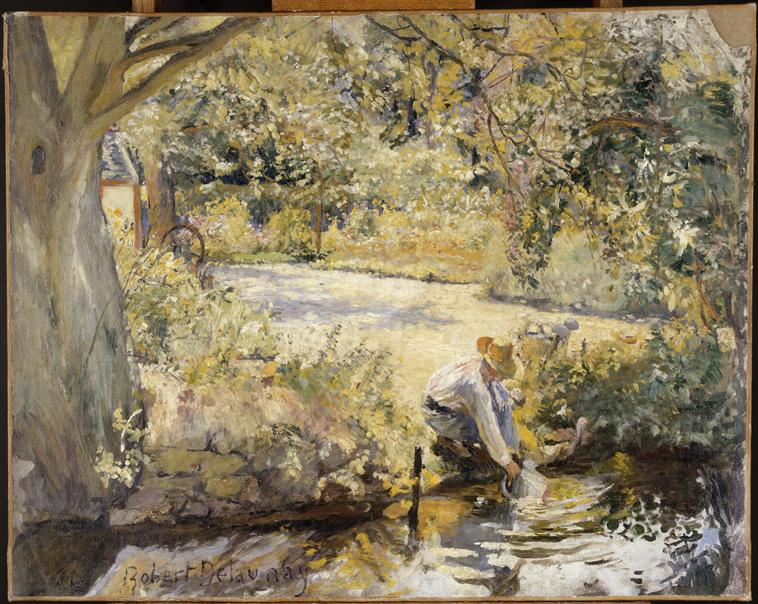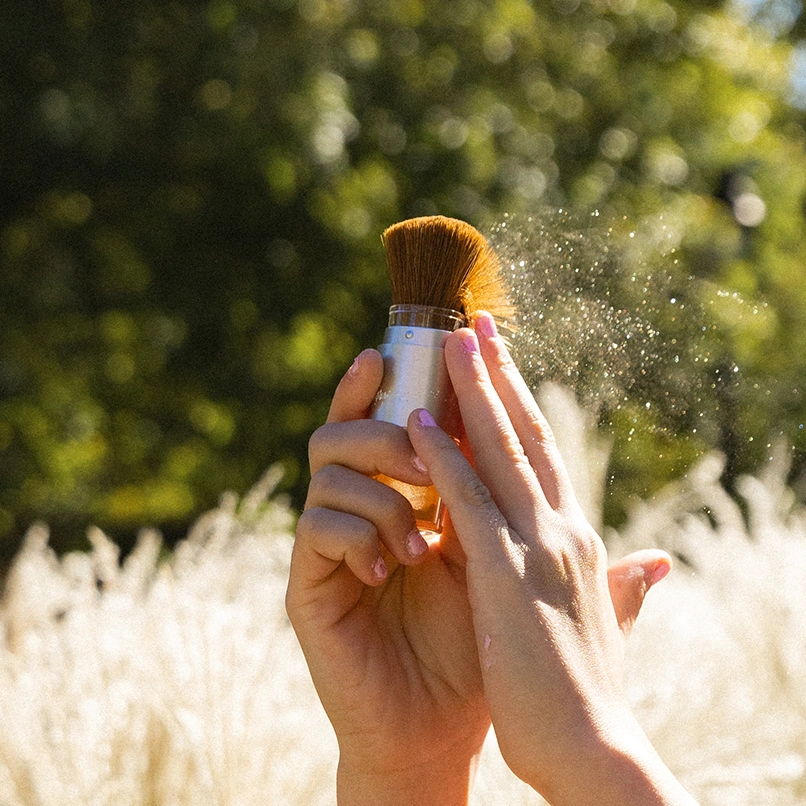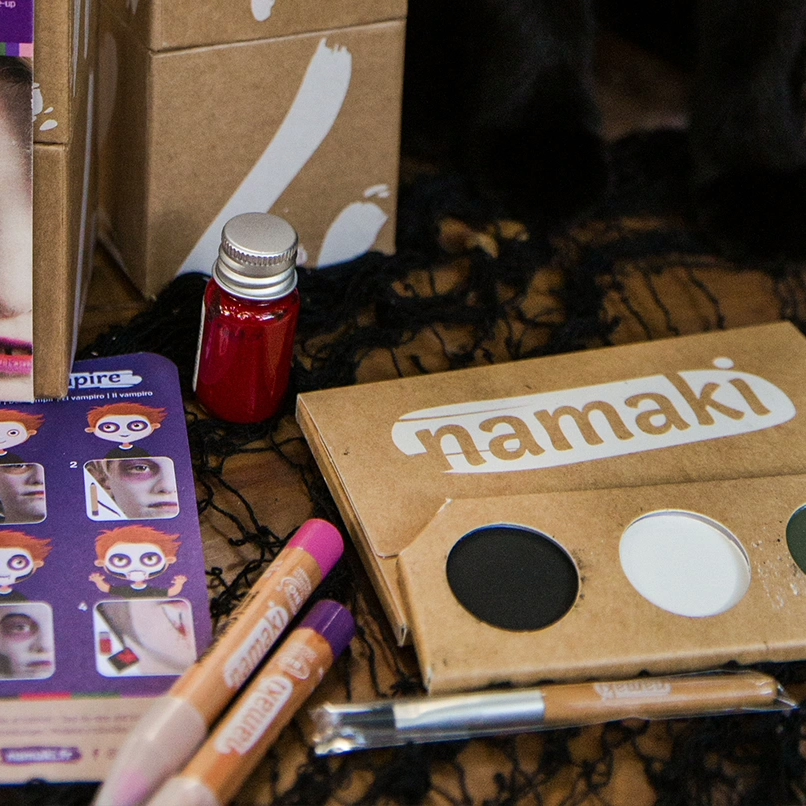Have you ever seen a moving painting? The Centre Pompidou and Namaki invite you to decipher the work Rythme, joie de vivre from Robert Delaunay. Follow us and you'll see how artists can add movement to their paintings.
Delaunay, a self-taught painter
From stage sets to paintings
Robert Delaunay was born in Paris in 1885. At the age of 17, he turned to theater set design. During these years, he was introduced to light and perspective, essential elements in theater. As for painting, he had never taken a course at the Beaux-Arts; he was a self-taught artist. Delaunay began by exhibiting Impressionist-inspired landscapes and flowers. At the time, painting reflected nature and life: blue was the color of the sky, green that of plants. But Delaunay and other painters like Fernand Léger were to revolutionize the use of color and form.

Robert Delaunay (1885-1941)
The banks of the Yèvre, 1903
Oil on canvas, 72,5 x 91,5 cm
The search for light and vibrating colors
Robert Delaunay wanted to make the vibration of colors and the act of seeing the very subject of painting. Like sound, each color has its own vibration. Two colors that are close to each other, such as yellow and orange, have similar vibrations and vibrate rapidly. Conversely, a yellow-orange next to a blue-violet in a composition will vibrate more slowly. These theories on simultaneous contrasts and color vibration were transposed as early as 1912 in the Window series. Delaunay's painting is thus not based on an interpretation of reality, for, in his words, "in art, light is the only reality."
💡Questions for your children Can you see the differences in vibration between these colors?
Delaunay, precursor of abstract art?
Painters, writers and philosophers are divided on Delaunay's contribution to the birth of the abstract movement, which began in 1910. According to Michel Seuphor, "abstract art is any art that contains no reminder or evocation of observed reality" (Abstract art, 1949). When painting his canvases - as, for example, in the Fenêtres series (1912-1913) - Delaunay sought his subject matter in the outside world, distorting it in favor of color and light. For some, Delaunay's poetic use of color makes him a precursor of abstract art. For others, only the canvases painted in the 1930s, including Rythme, joie de vivre, belong to this art-historical movement.
Rythme, Joie de Vivre: Delaunay's manifesto
Reconnecting with abstraction
In 1930, Delaunay returned to the theme of discs and Circular Forms (a series of canvases from 1912-1913). Rythme, Joie de vivre was a manifesto, a declaration of his artistic vision. Definitively abandoning Impressionist painting and portraits, he returned to abstract, colorful art. Far from representing life itself, the canvas literally expresses the joy of living through painting. Two other compositions painted in 1930 bear the same title. The abstract geometrical shapes and out-of-this-world color schemes take him directly back to the abstract movement.

Robert Delaunay (1885-1941)
Rhythm, Joie de vivre, 1930
Oil on Canvas, 200 x 228 cm
Giving rhythm and movement to the work
In this large format, concentric circles and semi-circles create an impression of movement. Like multicolored merry-go-rounds, they draw the eye into a whirlwind that only two diagonals seem able to stop. Variations in the size of the discs and the play of colors accentuate the effect of momentum and perpetual motion.
Create an optical effect with shapes and colors
With the exception of the disc in the top right-hand corner of the canvas, Delaunay uses the last four colors of the rainbow (red, orange, yellow and green) in his discs. The strong presence of warm hues accentuates the dynamic, vibrant effect of the painting. By focusing the eye on the aligned discs, the canvas hypnotizes and makes you dizzy. Assembled like constellations or gears, the discs give the painting both its percussive rhythm and its poetic atmosphere.
💡Questions for your children Do you know what an optical illusion is?
This is a distorted visual perception, usually of an image based on geometric elements. Staring at it, you can see lines moving, circles turning...
Kids' corner: inspiration for fun
Step 1
Look closely and imagine
An elephant with a big trunk? An eye watching you? By focusing your gaze on one part of the canvas rather than another, you can let your imagination run wild. So, what do you see?
Step 2
Become both artist and canvas
Thanks to the Namaki's face painting paletteyou too can play with colors and shapes. Drawing circles with a brush isn't always easy. Want a tip? Cut a circle out of cardboard and use it as a guide to draw the outline. Don't hesitate to mix colors to get even more color, and have fun drawing diagonals and half-circles too...
💡 Want to change color or shape? Don't worry, all you need is a little hot water and a glove to clean everything up and start again with a human blank sheet of paper!
Step 3
Move, turn, dance
Since movement is at the heart of this Delaunay canvas, why not take the opportunity to get moving? To the music you like, have fun dancing and spinning around. But don't get dizzy! To enlarge your movements, you can hold scarves in your hands or hang them from your wrists. A more challenging option if you like challenges with friends: you can also place a plate (cardboard, not Mom's pretty dishes, we agree), a Frisbee or a coin on your hand, and start dancing again without dropping them.
Going further with the "L'art en jeu" collection
Congratulations, you've just explored the corridors of Delaunay's imagination! To complete this reading, you can :
- Browse the the book dedicated to another famous Delaunay canvas, La Tour Eiffel, in the "L'art en Jeu" collection, published by Centre Pompidou Edition.
- Discover the painting Rhythm, Joie de Vivre at the Centre Pompidou.

Share this article









